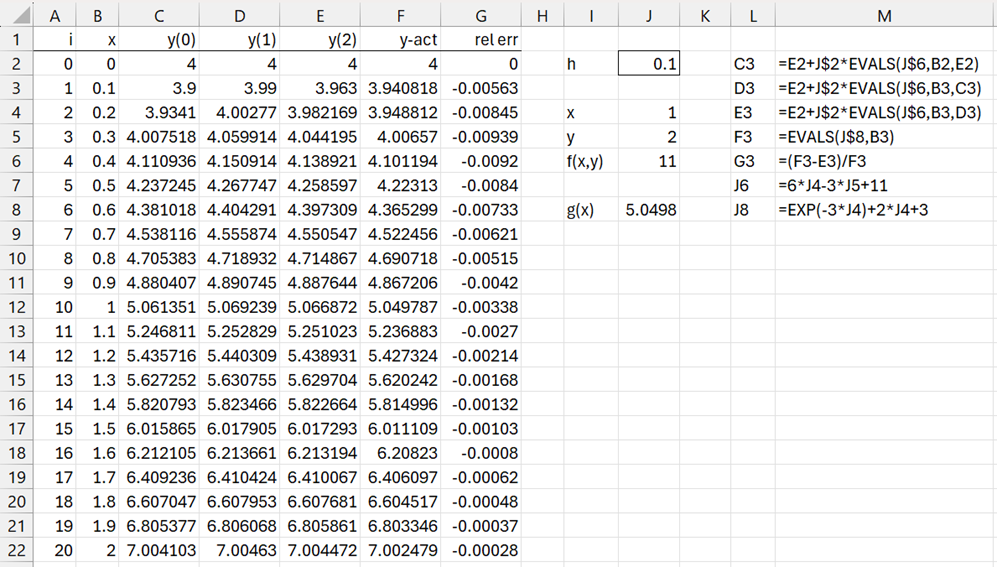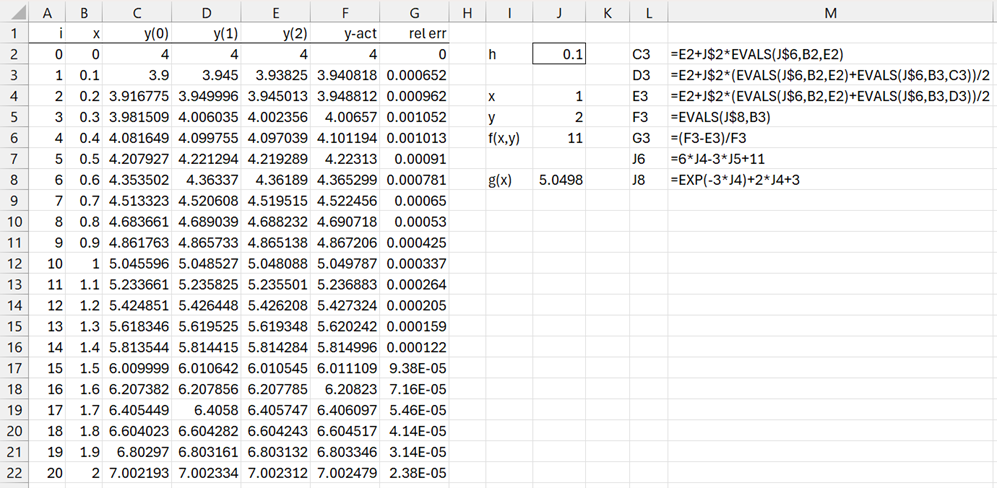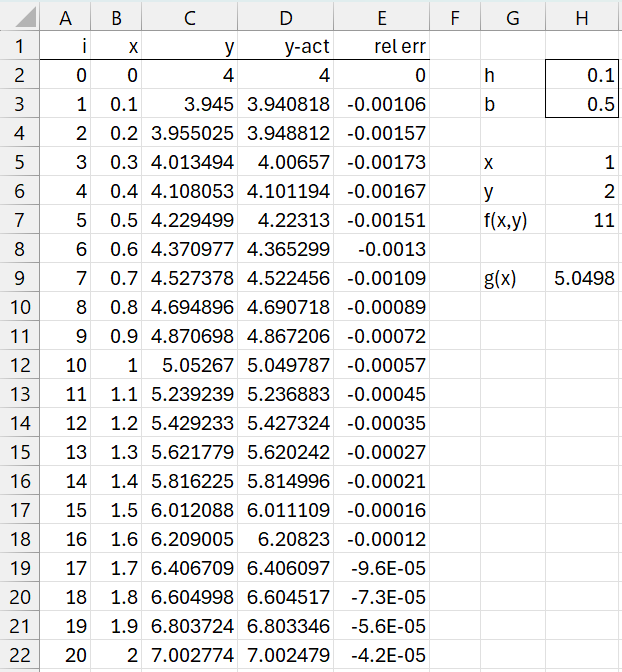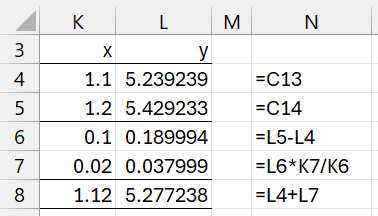Objective
Using the approach described in Euler’s Forward Method for solving differential equations, we now explore three other methods. These are Euler’s backward method, the Trapezoid method, and the Runge-Kutta method.
Euler’s Backward Method
This method is based on the following approximation to a derivative.
It follows that
This means that the system is characterized by
yi+1 = yi + h f(xi+1, yi+1) y0 = constant
Since we have yi+1 on both sides of the equation, we don’t have an explicit solution. Instead, we need to find the root of an equation of form
yi+1 – yi – h f(xi+1, yi+1) = 0
e.g. by using Newton’s method. Alternatively, we can make an initial estimate for yi+1 using Euler’s forward method, namely
We then apply a fixed point iterative approach as follows
Fortunately, convergence is usually quite rapid. One iteration is often sufficient, in which case
yi+1 = yi + h f(xi+1, yi + f(xi, yi))
Example 1: Repeat Example 2 of Euler’s Forward Method using Euler’s Backward method with two iterations.
The result is shown in Figure 1.
Figure 1 – Euler Backward Method
For this example, the results are fairly similar to those obtained for Example 2 in Euler’s Forward Method.
Trapezoid Method
As we see in Numerical Integration
This estimate is especially accurate over a small interval [a, b]
Thus to solve
y′(x) = f(x, y(x))
we can take the integral of both sides from xi to xi+1 to obtain
and so
This motivates the iterative process
As for the Euler Backward algorithm, this requires an implicit solution. A similar approach is to use the Euler Forward algorithm for the initial guess.
and then
Note that the Trapezoid method with one iteration is called Heun’s method.
Example 2: Repeat Example 1 using the Trapezoid method with two iterations.
The results are shown in Figure 2.
Figure 2 – Trapezoid method
This approach provides better estimates for y(2), with relative error of 0.00238%.
Runge-Kutta (RK2) method
This method attempts to make a better approximation by using an expanded version of the Taylor series. This method uses the following explicit iterative approach:
yi+1 = yi + hF(xi, yi)
where
 This means that
This means that
Typical choices for b are 1/2, 2/3, 3/4, and 1. The case where b = 1/2 is Heun’s method. b = 1 results in the midpoint method, and b = 2/3 is Ralston’s method.
Example 3: Repeat Example 1 using the Runge-Kutta Method with b = ½.
The results are shown in Figure 3.
Figure 3 – Runge-Kutta Method
Here, cell C3 contains the formula
=C2+H$2*(1-H$3)*EVALS(H$7,B2,C2)+ H$2*H$3*EVALS(H$7,B2+H$2/(2*H$3),C2+H$2/(2*H$3)*EVALS(H$7,B2,C2))
Not surprisingly, the estimate for y(2) is comparable to the Trapezoid method.
Runge-Kutta (RK4) method
There is an extended version of the Runge-Kutta method described above. This method uses the following iterative approach:
k1 = hf(xi, yi, zi)
k2 = hf(xi+h/2, yi+k1/2, zi+m1/2)
k3 = hf(xi+h/2, yi+k2/2, zi+m2/2)
k4 = hf(xi+h, yi+k3, zi+m3)
yi+1 = yi + (k1+2k2+2k3+k4)/6
See Differential Equations Analysis Tool for an example using RK4.
Interpolation
Example 4: Repeat Example 3 to find the solution to the differential equation when x = 1.12.
We have two choices. We could select a value of h that evenly divides 1.12. E.g. h = .01 or h = .02. If, however, we stick with h = .1, then we can use interpolation. To keep things simple, we will use linear interpolation (see Interpolation), as described in Figure 4 (with reference to the analysis shown in Figure 3).
Figure 4 – Linear interpolation
The linear interpolation estimate is y(1.12) = 5.277238 (cell L8).
Examples Workbook
Click here to download the Excel workbook with the examples described on this webpage.
References
Strang, G., Herman, E., Seeburger, P. (2025) Introduction to differential equations
https://math.libretexts.org/Courses/Monroe_Community_College/MTH_211_Calculus_II/Chapter_8%3A_Introduction_to_Differential_Equations/8.1%3A_Basics_of_Differential_Equations
Atkinson, K., Han, W., Stewart, D. (2009) Numerical solutions to ordinary differential equations. Wiley-Interscience
https://homepage.math.uiowa.edu/~atkinson/papers/NAODE_Book.pdf
Wilson, H. J. (2025) Ordinary differential equations
https://www.ucl.ac.uk/~ucahhwi/GM01/ODE_extra.pdf
Wikipedia (2025) Numerical methods for ordinary differential equations
https://en.wikipedia.org/wiki/Numerical_methods_for_ordinary_differential_equations






